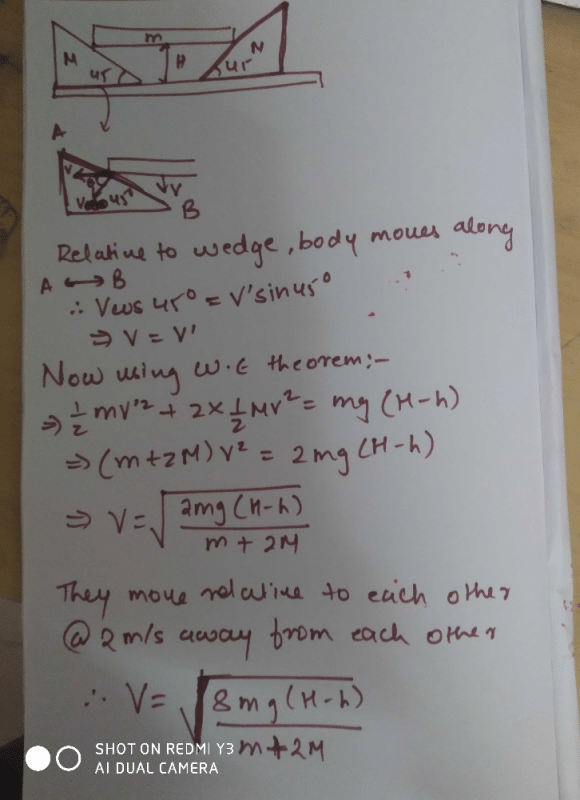Class 11 Exam > Class 11 Questions > A rigid body of mass m is held at a height on...
Start Learning for Free
A rigid body of mass m is held at a height on two smooth wedges are themselves at rest on a horizontal frictionless floor on releasing the body it moves down pushing aside the wedges . What is the velocity of reced of the wedge from each other when rigid body is at a height H from the ground?
Most Upvoted Answer
A rigid body of mass m is held at a height on two smooth wedges are th...

Community Answer
A rigid body of mass m is held at a height on two smooth wedges are th...
**Explanation:**
**1. Initial conditions:**
- The rigid body of mass m is held at a height H from the ground.
- The two smooth wedges are at rest on a horizontal frictionless floor.
**2. Release of the rigid body:**
- When the rigid body is released, it moves down due to gravity.
- As it moves down, it pushes aside the wedges.
**3. Conservation of momentum:**
- The total momentum of the system (rigid body + wedges) is conserved.
- Initially, the wedges are at rest, so their momentum is zero.
- Therefore, the total momentum of the system is initially zero.
**4. Motion of the rigid body:**
- As the rigid body moves down, it gains momentum.
- The momentum gained by the rigid body is equal and opposite to the momentum gained by the wedges.
- This is due to the conservation of momentum.
- The velocity gained by the rigid body can be calculated using the equation:
m * v = m * g * t
where v is the velocity gained by the rigid body, g is the acceleration due to gravity, and t is the time taken to reach the ground.
**5. Motion of the wedges:**
- The wedges move apart from each other as the rigid body pushes them aside.
- The velocity of recession of the wedges can be calculated using the equation:
v_w = (m * v) / (M1 + M2)
where v_w is the velocity of recession of the wedges, m is the mass of the rigid body, M1 and M2 are the masses of the wedges.
**6. Conclusion:**
- The velocity of recession of the wedges from each other when the rigid body is at a height H from the ground can be calculated using the above equation.
- The velocity of recession depends on the mass of the rigid body and the masses of the wedges.
- As the mass of the rigid body or the masses of the wedges increase, the velocity of recession will decrease.
- Similarly, as the height H from the ground increases, the velocity of recession will also increase due to the increased potential energy of the rigid body.
**1. Initial conditions:**
- The rigid body of mass m is held at a height H from the ground.
- The two smooth wedges are at rest on a horizontal frictionless floor.
**2. Release of the rigid body:**
- When the rigid body is released, it moves down due to gravity.
- As it moves down, it pushes aside the wedges.
**3. Conservation of momentum:**
- The total momentum of the system (rigid body + wedges) is conserved.
- Initially, the wedges are at rest, so their momentum is zero.
- Therefore, the total momentum of the system is initially zero.
**4. Motion of the rigid body:**
- As the rigid body moves down, it gains momentum.
- The momentum gained by the rigid body is equal and opposite to the momentum gained by the wedges.
- This is due to the conservation of momentum.
- The velocity gained by the rigid body can be calculated using the equation:
m * v = m * g * t
where v is the velocity gained by the rigid body, g is the acceleration due to gravity, and t is the time taken to reach the ground.
**5. Motion of the wedges:**
- The wedges move apart from each other as the rigid body pushes them aside.
- The velocity of recession of the wedges can be calculated using the equation:
v_w = (m * v) / (M1 + M2)
where v_w is the velocity of recession of the wedges, m is the mass of the rigid body, M1 and M2 are the masses of the wedges.
**6. Conclusion:**
- The velocity of recession of the wedges from each other when the rigid body is at a height H from the ground can be calculated using the above equation.
- The velocity of recession depends on the mass of the rigid body and the masses of the wedges.
- As the mass of the rigid body or the masses of the wedges increase, the velocity of recession will decrease.
- Similarly, as the height H from the ground increases, the velocity of recession will also increase due to the increased potential energy of the rigid body.

|
Explore Courses for Class 11 exam
|

|
Similar Class 11 Doubts
Question Description
A rigid body of mass m is held at a height on two smooth wedges are themselves at rest on a horizontal frictionless floor on releasing the body it moves down pushing aside the wedges . What is the velocity of reced of the wedge from each other when rigid body is at a height H from the ground? for Class 11 2025 is part of Class 11 preparation. The Question and answers have been prepared according to the Class 11 exam syllabus. Information about A rigid body of mass m is held at a height on two smooth wedges are themselves at rest on a horizontal frictionless floor on releasing the body it moves down pushing aside the wedges . What is the velocity of reced of the wedge from each other when rigid body is at a height H from the ground? covers all topics & solutions for Class 11 2025 Exam. Find important definitions, questions, meanings, examples, exercises and tests below for A rigid body of mass m is held at a height on two smooth wedges are themselves at rest on a horizontal frictionless floor on releasing the body it moves down pushing aside the wedges . What is the velocity of reced of the wedge from each other when rigid body is at a height H from the ground?.
A rigid body of mass m is held at a height on two smooth wedges are themselves at rest on a horizontal frictionless floor on releasing the body it moves down pushing aside the wedges . What is the velocity of reced of the wedge from each other when rigid body is at a height H from the ground? for Class 11 2025 is part of Class 11 preparation. The Question and answers have been prepared according to the Class 11 exam syllabus. Information about A rigid body of mass m is held at a height on two smooth wedges are themselves at rest on a horizontal frictionless floor on releasing the body it moves down pushing aside the wedges . What is the velocity of reced of the wedge from each other when rigid body is at a height H from the ground? covers all topics & solutions for Class 11 2025 Exam. Find important definitions, questions, meanings, examples, exercises and tests below for A rigid body of mass m is held at a height on two smooth wedges are themselves at rest on a horizontal frictionless floor on releasing the body it moves down pushing aside the wedges . What is the velocity of reced of the wedge from each other when rigid body is at a height H from the ground?.
Solutions for A rigid body of mass m is held at a height on two smooth wedges are themselves at rest on a horizontal frictionless floor on releasing the body it moves down pushing aside the wedges . What is the velocity of reced of the wedge from each other when rigid body is at a height H from the ground? in English & in Hindi are available as part of our courses for Class 11.
Download more important topics, notes, lectures and mock test series for Class 11 Exam by signing up for free.
Here you can find the meaning of A rigid body of mass m is held at a height on two smooth wedges are themselves at rest on a horizontal frictionless floor on releasing the body it moves down pushing aside the wedges . What is the velocity of reced of the wedge from each other when rigid body is at a height H from the ground? defined & explained in the simplest way possible. Besides giving the explanation of
A rigid body of mass m is held at a height on two smooth wedges are themselves at rest on a horizontal frictionless floor on releasing the body it moves down pushing aside the wedges . What is the velocity of reced of the wedge from each other when rigid body is at a height H from the ground?, a detailed solution for A rigid body of mass m is held at a height on two smooth wedges are themselves at rest on a horizontal frictionless floor on releasing the body it moves down pushing aside the wedges . What is the velocity of reced of the wedge from each other when rigid body is at a height H from the ground? has been provided alongside types of A rigid body of mass m is held at a height on two smooth wedges are themselves at rest on a horizontal frictionless floor on releasing the body it moves down pushing aside the wedges . What is the velocity of reced of the wedge from each other when rigid body is at a height H from the ground? theory, EduRev gives you an
ample number of questions to practice A rigid body of mass m is held at a height on two smooth wedges are themselves at rest on a horizontal frictionless floor on releasing the body it moves down pushing aside the wedges . What is the velocity of reced of the wedge from each other when rigid body is at a height H from the ground? tests, examples and also practice Class 11 tests.

|
Explore Courses for Class 11 exam
|

|
Signup to solve all Doubts
Signup to see your scores go up within 7 days! Learn & Practice with 1000+ FREE Notes, Videos & Tests.





















